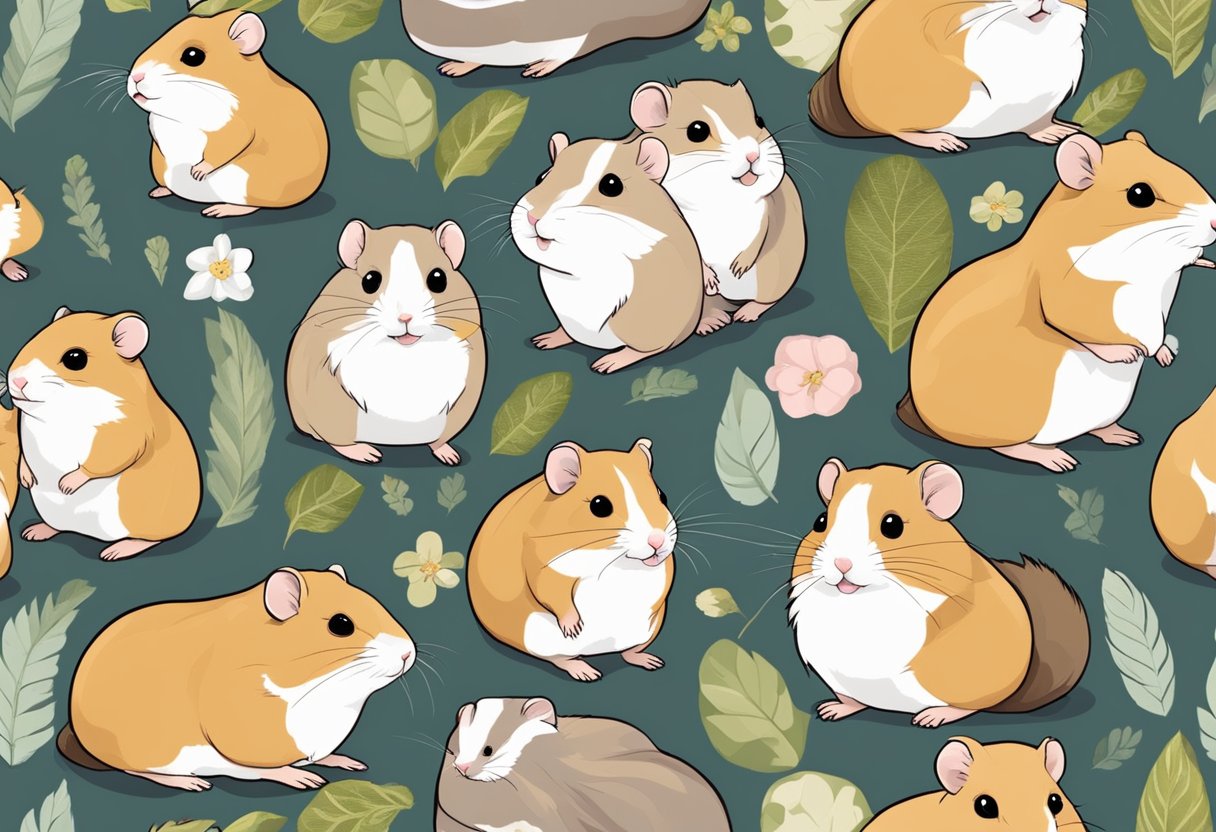Types Of Hamsters
Hamsters are popular pets that have been kept for centuries. They are small, furry, and adorable, making them a favorite among pet lovers. There are many different types of hamsters, each with their own unique characteristics, behaviors, and care requirements. In this article, we will explore the various types of hamsters, their physical features, habitats, and conservation status.
Popular Hamster Breeds:
The most commonly kept hamster breeds include Syrian, dwarf, and Chinese hamsters. Syrian hamsters, also known as golden hamsters, are the largest of the three and can grow up to seven inches long. Dwarf hamsters, on the other hand, are much smaller and come in several different species, including Campbell’s, winter white, and Roborovski. Chinese hamsters are somewhere in between, with a slender body and a tail that is longer than other hamsters.
Key Takeaways:
- There are many different types of hamsters, each with their own unique characteristics, behaviors, and care requirements.
- The most commonly kept hamster breeds include Syrian, dwarf, and Chinese hamsters.
- When choosing a hamster, it’s important to consider their size, temperament, and lifespan, as well as their suitability for handling or living in groups.
Popular Hamster Breeds

When it comes to popular hamster breeds, there are a few that stand out among the rest. The three most popular breeds are Syrian Hamsters, Dwarf Hamsters, and Chinese Hamsters. Each breed has its own unique characteristics that make them popular choices for pet owners.
Syrian Hamster
Syrian Hamsters, also known as Golden Hamsters, are one of the most popular hamster breeds. They are larger than most other breeds, growing up to 7 inches in length. They are also known for their friendly and curious personalities. Syrian Hamsters come in a variety of colors, including golden, cinnamon, and black.
Dwarf Hamsters
Dwarf Hamsters are smaller than Syrian Hamsters, growing to only 3-4 inches in length. There are three main types of Dwarf Hamsters: Campbell’s Dwarf Hamster, Winter White Dwarf Hamster, and Roborovski Dwarf Hamster. They are known for their fast and active personalities, making them a popular choice for pet owners who want an energetic pet.
- Campbell’s Dwarf Hamster: These hamsters are social and enjoy living in pairs or groups. They come in a variety of colors, including gray, brown, and white.
- Winter White Dwarf Hamster: These hamsters are known for their ability to change color with the seasons. In the winter, they turn white to blend in with the snow, and in the summer, they turn gray-brown. They are social and enjoy living in pairs or groups.
- Roborovski Dwarf Hamster: These hamsters are the smallest of the Dwarf Hamster breeds, growing to only 2 inches in length. They are known for their fast and active personalities, making them a popular choice for pet owners who want an energetic pet.
Chinese Hamster
Chinese Hamsters are similar in size to Dwarf Hamsters, growing to only 3-4 inches in length. They are known for their long tails and sleek appearance. Chinese Hamsters are generally more timid than other hamster breeds, but they can become friendly with regular handling. They come in a variety of colors, including gray, brown, and white.
In conclusion, when it comes to popular hamster breeds, Syrian Hamsters, Dwarf Hamsters, and Chinese Hamsters are the top choices among pet owners. Each breed has its own unique characteristics that make them a great choice for different types of pet owners.
Hamster Care Essentials
When it comes to caring for hamsters, there are a few essential things to keep in mind. In this section, we’ll cover the most important aspects of hamster care, including habitat requirements, nutrition and diet, and health and lifespan.
Habitat Requirements
Hamsters need a safe, comfortable, and stimulating environment to thrive. Here are a few things to keep in mind when setting up your hamster’s habitat:
- Cage: Hamsters need a spacious cage with plenty of room to move around. A good rule of thumb is to provide at least 360 square inches of floor space. The cage should also have a solid bottom to prevent injury and allow for easy cleaning.
- Bedding: A soft, absorbent bedding material is essential for hamsters. Avoid cedar and pine shavings, as they can be harmful to your pet’s respiratory system. Instead, opt for paper-based or aspen bedding.
- Tunnels: Hamsters love to burrow and explore, so providing tunnels and hideouts in their cage is a must. You can buy pre-made tunnels or make your own using cardboard tubes or PVC pipes.
- Exercise Wheel: Hamsters need plenty of exercise to stay healthy and happy. An exercise wheel is a great way to provide them with an outlet for their energy. Make sure the wheel is large enough for your hamster and has a solid surface to prevent foot injuries.
Nutrition and Diet
A balanced diet is essential for your hamster’s health and wellbeing. Here are a few things to keep in mind when it comes to feeding your pet:
- Food: Choose a high-quality hamster food that contains a mix of seeds, grains, and other nutritious ingredients. You can also supplement your hamster’s diet with fresh vegetables, fruits, and nuts.
- Water: Make sure your hamster always has access to fresh, clean water. A water bottle is the best option, as it prevents spills and contamination.
- Teeth: Hamsters’ teeth never stop growing, so it’s important to provide them with plenty of chew toys and hard foods to help wear down their teeth.
Health and Lifespan
Hamsters are generally healthy pets, but they can still develop health problems if not cared for properly. Here are a few things to keep in mind when it comes to your hamster’s health and lifespan:
- Lifespan: Hamsters typically live for 1-2 years, but some can live up to 5 years with proper care.
- Fur: Hamsters groom themselves regularly, but you can help keep their fur healthy by providing them with a dust bath once a week.
- Teeth: Overgrown teeth can be a sign of health problems, so it’s important to keep an eye on your hamster’s teeth and take them to the vet if you notice any issues.
- Vegetables and Fruits: While hamsters can eat fresh vegetables and fruits, it’s important to do so in moderation. Too much can cause digestive problems.
- Nuts: Nuts are a great source of protein and healthy fats, but they should be given sparingly as they are high in calories.
Behavior and Social Traits
Hamsters are known for their unique behavior and social traits, which can vary depending on the breed and individual personality. Understanding these traits is essential for providing proper care and ensuring a happy and healthy life for your hamster.
Temperament
Hamsters have different temperaments, and it’s important to choose a breed that suits your lifestyle and personality. Syrian hamsters, for example, are known for their friendly and docile nature, while dwarf hamsters can be more territorial and aggressive.
Hamsters can also exhibit different personalities, even within the same breed. Some hamsters may be more outgoing and adventurous, while others may be more shy and reserved. It’s important to spend time with your hamster and observe their behavior to understand their unique personality.
Social Interaction
While hamsters are generally solitary animals, they still require social interaction and stimulation. Providing toys, tunnels, and other forms of enrichment can help keep your hamster active and engaged.
It’s also important to handle your hamster regularly to build trust and prevent them from becoming aggressive. However, it’s important to note that hamsters may bite if they feel threatened or scared, so it’s important to handle them gently and with care.
Activity Patterns
Hamsters are nocturnal or crepuscular, which means they are most active at night or during dawn and dusk. This can be important to consider when setting up their habitat, as they will need a quiet and dark space to sleep during the day.
Hamsters are also territorial animals and may exhibit aggressive behavior towards other hamsters, especially if they are of the same gender. It’s important to provide separate living spaces for hamsters of different genders to prevent fighting and injury.
In summary, understanding the behavior and social traits of your hamster is essential for providing proper care and ensuring their wellbeing. By observing their temperament, providing social interaction and enrichment, and considering their activity patterns, you can help ensure a happy and healthy life for your furry friend.
Choosing the Right Hamster
When it comes to choosing the right hamster, there are a few things to consider. Here are some factors to keep in mind:
Considering Hamster Sizes
Hamsters come in different sizes, and it’s important to choose one that suits your lifestyle and living space. The Syrian hamster is the largest species and can grow up to 6-7 inches in length, while dwarf hamsters are much smaller, measuring only about 2-4 inches in length. If you have limited space, a dwarf hamster may be a better option, while a Syrian hamster may be more suitable for those with larger living spaces.
Suitability for Families
Hamsters can make great family pets, but it’s important to choose the right breed. Syrian hamsters are often recommended for families with children, as they are larger and easier to handle. Dwarf hamsters, on the other hand, may not be the best choice for families with young children, as they are more delicate and require gentle handling.
Hamster Personalities
Each hamster has its own unique personality, and it’s important to choose one that matches your lifestyle. Some hamsters are more active and playful, while others are more relaxed and prefer to sleep during the day. It’s important to spend time with your potential pet to get a sense of their personality and see if they are a good fit for you.
Overall, hamsters can make great pets for those who are willing to provide them with the proper care and attention. By considering factors such as size, suitability for families, and personality, you can choose the right hamster for your lifestyle and living space.
Hamster Species in the Wild
There are many different species of hamsters that can be found in the wild. Some of the most common species include the European hamster, the Ciscaucasian hamster, and various species of wild hamsters found in Mongolia and Central Asia.
The European hamster, also known as the black-bellied hamster, is a species of hamster that is native to Europe. They are typically found in grasslands, farmland, and other open areas. These hamsters are known for their large size and distinctive black belly.
The Ciscaucasian hamster is another species of hamster that is found in the wild. They are native to the Caucasus region of Eurasia and are typically found in grasslands and other open areas. These hamsters are known for their distinctive coloring and are often kept as pets.
Wild hamsters are found throughout much of Europe and Asia. They are typically found in grasslands, deserts, and other open areas. These hamsters are known for their small size and are often preyed upon by larger animals.
In Mongolia and Central Asia, there are several different species of wild hamsters that can be found. These hamsters are typically found in desert or semi-desert areas and are known for their ability to survive in harsh environments. Some of the most common species include the Kam dwarf hamster and the Chinese striped hamster.
Overall, there are many different species of hamsters that can be found in the wild. Whether you are interested in the European hamster, the Ciscaucasian hamster, or one of the many species of wild hamsters found in Mongolia and Central Asia, there is sure to be a hamster species that will capture your interest.






